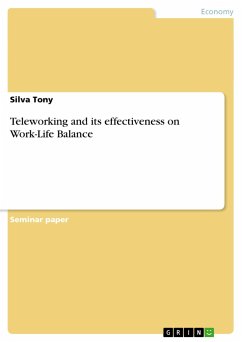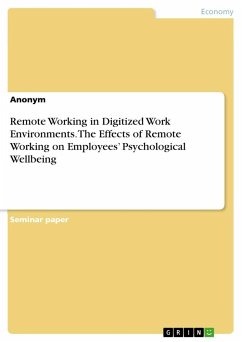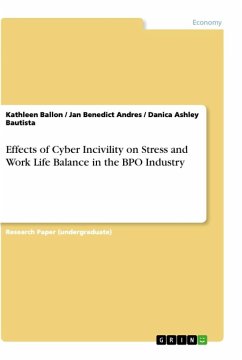Seminar paper from the year 2011 in the subject Leadership and Human Resource Management - Miscellaneous, grade: A, The University of Chicago, language: English, abstract: In the recent past Telework which is a flexible way of working has attracted a huge deal of discussion because of its complex implications on people organizations as well as the society to be able to work at anyplace and at any time. Though, at the moment is no a common accepted description for telework, (Hartig, 2007). O'Mahony & Barley (1999) describe telework as a working by the use of information and communication technologies to facilitate employees and their managers to access their work from distant locations. Though there has been a substantial increase of teleworkers starting from the 1990s, the dispersion of telework has not developed as it was expected. This is unexpected since latest advancement in ICT has considerable decrease the management and coordination expenses that are related with the geographic dispersion of the workforce's position. Several experts assert that adopting telework is directed by others factors and that are not necessarily technological. While other experts like O'Mahony & Barley (1999 suggest that when analyzing telework, cultural social and even political actors should not be ignored. Hartig (2007) established that worker independence was more crucial compared to technological factor to successful implement telework. This research paper seeks to find study teleworking and its effectiveness on Work-Life Balance among employees in an organization. The research paper will review past studies carried out on this subject into order to answer the subject.A number of recent tendencies in the recent past have focused extra attention on teleworking. One, there is an increasing trend of achieving an improved work-life balance from teleworking (e.g. Hartig, 2007), Golden et al (2006) general the possibility of achieving improved work-life balance in all regions may not be realized soon Hartig, 2007). Two, there is growing evidence that offering telework results in improved performance of the organization and the teleworker, and it also reduces cases of absenteeism (Stavrou 2005). At the same time is possible that teleworking could help in countries with labor shortage by enabling more women who have younger children to get back to the labor market and be employed as teleworker...
Hinweis: Dieser Artikel kann nur an eine deutsche Lieferadresse ausgeliefert werden.
Hinweis: Dieser Artikel kann nur an eine deutsche Lieferadresse ausgeliefert werden.








